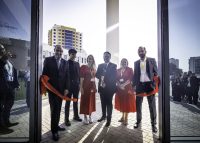The Middle East and Africa’s education technology and smart classroom market is estimated to grow to Dh26 billion ($7.1bn) by 2027, as per a report by The Insight Partners.
As the pandemic has accelerated the shift to digital education, the widespread adoption of smartphones, interactive displays and other digital learning tools in classrooms are crucial drivers of this growth.
GCC has been quick in embracing technology in classrooms. Ever since schools closed to control the spread of the pandemic, many public schools have adopted smart classrooms. Regulators in Saudi Arabia, UAE and Qatar have seen it as an essential method to transform the traditional mode of instruction.
Max Hsu spoke to Education Middle East about GCC’s growing interest to embrace innovative tech solutions in the classroom, the evolution of smart classrooms to cater to hybrid learning needs and the future of video-assisted learning.
Max Hsu is the Regional Director for ViewSonic Operations in the Middle East and Africa. He started his journey with the company in 2014 when he joined the Taipei office of ViewSonic International Corporation as Director for Product Marketing. Thereafter, he was promoted to Sales Director – MEA & India. Meanwhile, as Director for Business Line he developed new countries’ business, achieving an average of 30% growth in different markets. In 2018 Hsu was appointed as the Regional Director for the MEA region, and since then he along with his team have been achieving more than 25%~50% YoY growth.
With hybrid learning here to stay, how has the smart classroom evolved to suit the requirements of this new reality?
The COVID-19 pandemic has resulted in some dramatic changes in the education system. While the adoption of hybrid learning has accelerated rapidly across the globe, it has also increased the demand for high-end solutions.
For today’s learning situations, the smart classroom concept is a great innovation. It provides opportunities to enhance the learning experience for students where they are engaged for longer periods of time with audio and video tools. It is the interactive element that makes this a game changer, enabling real-time discourse between teachers and students. ViewSonic has been a leader in developing world-class solutions to support teachers and students in all kinds of learning scenarios, whether it is in-person classes, online classes or hybrid-learning.
While ViewSonic introduced smart classroom solutions such as Interactive flat panels and myViewBoard, a whiteboard platform, four years back, it was the sudden changes due to COVID-19 that prompted us to create more advanced tools within myViewBoard to suit the new requirements. Hence, we launched Classroom, a versatile classroom management tool to connect teachers and students for better engagement. Its advanced features encourage students’ participation during the sessions. Meanwhile, our 4k ultra-wide camera & conference speakerphone enhanced the hybrid learning experience for both educators and students. The pen display provided a smoother engagement experience for both, in-person and distance learning.
Has the growing significance for teacher-student collaboration impacted the design of the classroom?
For effective collaborative learning it is crucial to have flexible classroom designs. Earlier, the approach was more teacher-centric. Students were required to have eyes on their teachers, the blackboard or overhead projector for the teacher was at the front of the room and students had pencil and paper to take notes. With rapid changes, these traditional approaches might not be as effective as it was earlier.
21st-century design gives more scope for flexibility for teacher-student and student-to-student collaboration. Flexible seating, collaborative configurations and huddle spaces are the way forward.
Flexible seating creates learning environments that can be continuously adapted for changing needs. The ability to rearrange components supports constructive learning among students. Couches, floor pillows, bean bag chairs and traditional chair/desk combos are all seating possibilities in this scenario.
Collaborative configurations replace single workspaces with large round or rectangular tables. The idea here is to put desks together to form collaborative workspaces.
An extension of the business world, huddle spaces now reign in the classroom. These spaces offer convenient seating plus technology like audio, display and sharing software. These tech-laden spaces foster exactly what 21st-century educators seek: active, constructivist learning. Huddle spaces typically feature an interactive display or smart display. Content sharing capabilities lets students easily display material from their smartphones, tablets and laptops.
What does the future hold for video-assisted learning?
Today’s generation is becoming increasingly visual. The more appealing visual content for learning, the better. It is making some visible impact on students’ learning and remembering capabilities.
Video-assisted learning models are doing wonders for students with special educational needs and disabilities or other learning challenges. Looking at the rapidly changing education scenario, the future of video as an aide for learning looks promising. With projectors and interactive displays taking centerstage, video-assisted learning is here to stay.
Tell us about the adoption of tech solutions in the classroom in GCC.
GCC schools in general are open to EdTech solutions. Of late, ministries of education have shown interest in implementing EdTech solutions in public schools as they’ve realized the benefits, they offer to both educators and students. Learning from anywhere without limitations has become possible thanks to technology in education.
ViewSonic is currently working with Tetco in Saudi Arabia to install our EdTech solution in public schools across the kingdom. We are also working on similar projects for schools and universities in the UAE and Qatar.
Can you share some tips for schools wanting to upgrade their smart classrooms to suit the needs of hybrid learning.
Classroom design has come a long way in the last few decades. We are seeing a massive shift away from the classroom’s origins as rigid, structured places of teacher-centered learning. Instead, classrooms are embracing technology and more flexible approaches to learning for the benefit of students and teachers.
To have a successful active learning space, it is important to include well-matched EdTech resources. Here are some tips for schools interested in upgrading their classrooms. The most common ways to leverage technology for constructivist learning includes:
Front of Room Display
We’ve come a long way since the humble blackboard. Today’s educators need a powerful, multi-tasking classroom display. They want to easily display online content. They want their students to actively interact with content. They want the ability to annotate on top of any content, from any source. When they can record the content, annotations, and surrounding audio, they can share digital content files. ViewSonic offers a range of options to fit any budget. Products include interactive flat panels (ViewBoards), Pen displays & accessories.
Interactive Software
Add interactive software to amp up the capabilities of existing flat panel displays. ViewSonic myViewBoard suites for education deliver robust interactive features that bring lessons to life. The powerful software supports direct file saving to Google Drive and encourages active engagement.
Huddle Spaces/Learning Labs
Call them what you want, these tech-enabled spaces foster active, collaborative learning. Featuring an interactive display and content sharing capabilities for students, these future-forward classrooms leverage technology to create spaces that promote active engagement and meaningful learning. ViewSonic offers a wide range of technologies that bring greater interactivity and collaboration to any classroom’s front of room display, huddle stations, desktops, learning labs and more.
Tell us about ViewSonic’s most popular solutions for classrooms.
ViewBoard and myViewBoard are ViewSonic’s most popular solutions. The reason for its popularity is that it provides a hardware and software solution for in-class, hybrid, and distance learning, along with magnificent features and integration with 3rd party applications that enable teachers to manage and facilitate the classroom sessions better, specially when a school creates Entity account that provides additional features to users, and we are glad to say that since COVID-19 pandemic we are offering mvViewBoard Entity Account for Free to support schools and educators in adapting to the new changes and new way of learning.
Ed-tech products generally require intensive onboarding. Is it the case with ViewSonic too?
Onboarding has never been a hassle for any of our clients as it has always been ViewSonic’s top most priority. To assist our clients with services, we are expanding our team. This has enabled us to provide strong post-sales services such as training, workshops, and technical support to all our end users.
While choosing interactive displays for the classroom, what factors should be taken into consideration by a school?
While choosing interactive displays, it is important to consider how good its connectivity and digital software are as most teachers struggle with fixing technical issues and compatibility problems when heading into class. Similarly, a good interactive display should be equipped with advanced audio and eye-care features as it will all have a significantly positive impact on student engagement. For schools considering implementation of multiple interactive displays, a comprehensive management system will greatly reduce the strain on IT teams.








